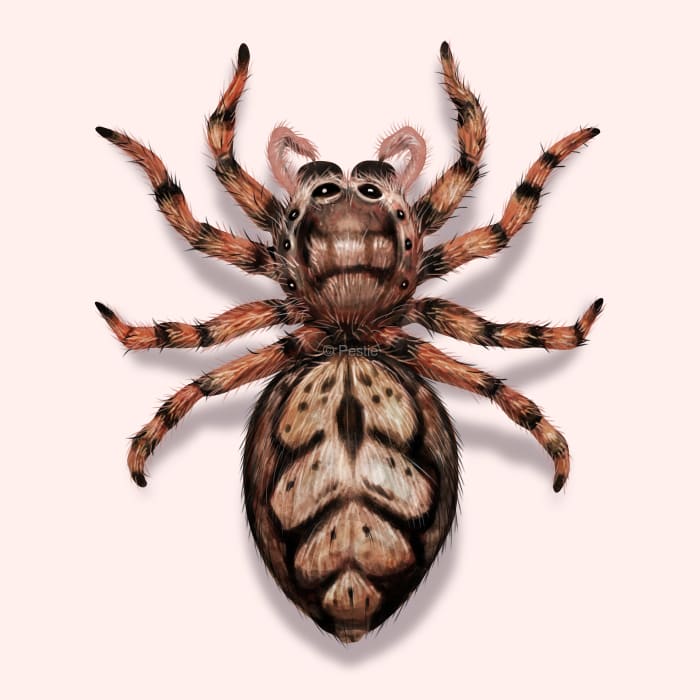How to identify and get rid of jumping spiders

The jumping spider: the cutest pest in your home
Spiders aren’t always welcome guests in our homes, and millions of people have an irrational fear of spiders.
But if only they could meet the adorable jumping spider, then they would have a friendly ambassador into the fascinating world of spiders.
Jumping spiders belong to a family of spiders with over 6,000 species worldwide and around 300 species in the US. They come in a variety of colors. While they don’t spin webs to catch their prey, they do trail a safety web behind them as they spring onto their prey and actively hunt their dinner.
How to identify jumping spiders
Jumping spiders have a very distinct look from other types of spiders. While they come in all sorts of colors and patterns, they typically have short legs that they hold close to their bodies.
One of the best ways to identify a jumping spider is to look deep into their eyes, but not too deep!
Jumping spiders have four pairs of eyes and two of those eyes are forward-facing and usually larger than the others.
How big are jumping spiders?
Most jumping spiders are pretty small, measuring between ¼ inch to ¾ in.
What other spiders look like a jumping spider?
Because of the markings on various species of jumping spiders, you might confuse a jumping spider like the orchard jumping spider or black jumping spider with a black widow. Just remember that jumping spiders don’t build webs to catch prey and they are fuzzy, unlike the black widow.
Where do jumping spiders live?
Jumping spiders can live in a variety of habitats all over the world, with one species even living on the slopes of Mt. Everest! But, you are most likely to find them near forested areas in the US. They like to hide in vegetation, wood piles, and rocky areas.
They can wander into your home from time to time, looking for insects to eat. So, if you find jumping spiders in your home, you might have other insects to watch out for too!
How to get rid of jumping spiders
Since jumping spiders wander around to hunt for their prey, they might accidentally enter your home. They like sunny windows where other home invaders might hang out, like mosquitos, flies, or stink bugs.
Prevention is the best way to keep spiders out. Fill in cracks or openings around windows, fix broken screens, or check items that have been outside for a while before bringing them in. If you find a single spider in your home, vacuum it up and then dispose of the bag outside.
A pro-grade solution like Pestie can protect your home from insect invaders, which can deter spiders from entering your home as well. Our DIY subscription offers the same powerful products the pros use, delivered right to your door. Now, you can skip the hassle of dealing with a pest control company and conveniently have a pest-free home.
Treat jumping spiders with Pestie
If you're still having trouble keeping jumping spiders away, the best option is to use a pro-grade, effective pest control solution like Pestie.
Pestie is a do-it-yourself pest control solution that's specially designed to keep jumping spiders and other pests away from your home.
With Pestie, you can rest easy knowing that your living space is protected and free of creepy crawlies. And the best part? It's designed for people, pets, and the planet, so you can say goodbye to harsh chemicals and hello to peace of mind!
- Save hundreds compared to traditional annual pest plans
- People, pet, and planet-friendly
- Pro-grade customized formulas
Quick facts
- Scientific name
Family - Salticidae
- Colors
Black, red, orange, tan, grey, sometimes with vibrant colored markings
- Life span
6 months - 2 years, 3 years in captivity
- Diet
Mostly other insects and arthropods
How dangerous are Jumping Spiders?
Low danger risk
Jumping spiders are relatively harmless and will usually crawl or jump away when disturbed. However, they can sometimes be a little curious too, and have been known to interact with humans.
Like most spiders, they are venomous and can bite when disturbed or threatened, but they don’t have enough venom in their bites to do much harm. They don’t even have very powerful bites, and may not be able to break your skin.
Because of the way the retinas of their large eyes change colors and can move around, it is said that if you are seeing the retina at its darkest color, then the spider is looking at you!








